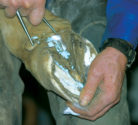Advertise Follow Us
Items Tagged with 'iodine'
ARTICLES
Educating Your Clients on Supplements
Vitamins, minerals, amino acids and even algae can support healthy feet and joints
Read More
Research Journal: April 2016
The information, ideas and opinions expressed are those of the author and do not necessarily represent those of the United States Department of Agriculture.
Read More
Hoof Nutrition Intelligence
Is there a need for including iodine in the horse’s diet for development of a high-quality hoof?
Read MoreLots Of Confusion Regarding Equine Metabolic Syndrome
It can be tough for farriers to separate equine metabolic syndrome from Cushing’s disease when dealing with laminitis concerns
Read More
Dealing with Thrush and White Line Disease
Combining topical treatments with good hoof care will help you keep these common problems under control
Read More








